Professional FCPX Film and TV Workflows
When it comes to professional workflows for broadcast film and TV productions, there are plenty of people working with FCPX right at the heart of what they do and at some of the highest levels of the industry.
In this post I’ve brought together some of the best workflow case studies, presentations and articles on using FCPX to cut TV shows, trailers, feature film and commercials. I’ve also added a little section on ‘switching’ to FCPX which covers a few of the compelling reasons to start working in FCPX.
But to kick things off, if you’ve not already seen it, is the 7th instalment of the FCPX Virtual User Group, in which the usual cast of characters sit around some very cool looking Cintiq Wacom tablets, sharing their FCPX tips and tricks. The best way to watch this, and future episodes is via the Hazu page, which allows you to interact with the show whilst it’s being live-streamed.
After the fact it also lets you jump to specific moments during the 2 hour show and see all the questions related to that segment. It’s pretty useful. You can jump to all the previous VFCPXUG episodes on Hazu here.
Sam Mestman starts the show with his walk through of how to set things up correctly to use FCPX in a shared environment. I recently interview Sam about the multitude of things he does and the fast Lumaforge Jellyfish shared storage here.
Switching to FCPX
https://vimeo.com/161710321
This short video from Light Iron CEO Michael Cioni helps to introduce the idea of why FCPX is different to other NLE’s and how it’s changing the editorial paradigm. As you watch Michael’s intro ask yourself: Can I do all this in the current way I’m working?
FCPX is an advanced database sitting on top of an NLE. Once you embrace and understand the logic behind that, it enables you to open up the editing process that was never previously possible.
I originally included this video and a large number of other fantastic resources on the making of Whisky Tango Foxtrot in this previous post.
https://vimeo.com/164787272
In this FCPeXchange presentation from NAB 2016 FCPX trailer editor Charlie Austin you can learn how he leverages FCPX and third party plugins to get his work done on a daily basis. Charlie references his (excellent) blog on FCPX tips and tricks during his talk which includes some great breakdowns of some of the VFX work he’s done on a few different trailers all inside of FCPX.
https://vimeo.com/153989491
This 1 minute tip video from 1st Assistant Editor Mike Matazdorff helps explain the power of using Smart Collections to organise your media and manage your workflow through the edit suite to other departments. Check out more of these great tips in this previous FCPX post on Advanced Workflows and Tutorials to get a better understanding of how FCPX works differently.
I think you’d need to have some basic knowledge of FCPX and editorial workflows to join the dots in a few places, but it’s a really interesting talk from one of FCPX’s most inventive editors. You can get a few extra notes from Charlie on his presentation in this blog post and a download of the slides if you want to see things in more detail.
In this 40 minute presentation from a LACPUG evening, Steve Martin from Ripple Training addresses the question of all the ‘missing features’ in the FCPX native app and the eco-system of plugins that have risen up to meet those needs. Steve walks through a list of his personal ‘must have’ plugins that cover the following tasks – “Fix it in Post”, Colour Grading, Titles and Graphics, Audio and Productivity.
Steve’s 10 essential plugins are:
- Coremelt’s Track X and Slice X
- Colour Grading Central’s LUT Utility and Color Finale
- Neat Video Noise Remover
- Ripple Training’s Text Callouts on FX Factory
- Ripple Training’s (Free) 3D Title Animations
- MotionVFX’s mflares
- iZotope RX5 Audio Editor ($349 version)
- Intelligent Assistance’s Producer’s Best Friend
It’s nice to see each of these plugins briefly demoed to get a proper sense of what they are capable of and how you actually use them. If you’re new to FCPX this will definitely help you speed up your editing and discover some handy apps.
For even more tutorials on the ‘different’ ways of doing things in FCPX check out these previous posts
Understanding the Magnetic Timeline | The Beginner’s Guide to Learning FCPX | Feature Film Workflows (in Avid, Premiere and FCPX) | FCPX Twitter Tips
FCPX Broadcast TV Workflows
https://vimeo.com/164787273
In this trio of presentations from the most recent FCPeXchange event you can hear how FCPX is being used in broadcast TV workflows. The first presentation walks through how one of Denmark’s largest production companies, Metronome, has used FCPX to get more than 300 TV episodes over 35 seasons out the door.
As Sam mentions in his intro you can also read lengthy and well illustrated case study of their workflow on FCP.co, which dives into the technical details of the hardware set up, multi-editor collaborative workflow and much more.
https://vimeo.com/164787271
Inverleigh TV in Melbourne have transitioned from FCP7 to FCPX and is working from a Lumaforge Sharestation. Inverleigh produce 12-14 TV shows a week, creating over 350 hours of content every year. They also need to manage 2000 hours of library content and let 60+ editors work simultaneously across their facility.
It’s interesting to hear how important events like FCPeXchange are in helping companies learn from each other and share their broadcast reliable methodologies with each other.
32 minutes in to the video Philip Hodgetts demo’s Magic Keywords in his Lumberjack pre-editing system which leverages FCPX unique keyword ranges for some incredibly efficient editing.
https://vimeo.com/164772143
If you’re working in a bigger facility or company with a lot of media assets to keep track of, then robust and efficient Asset Management is crucial. In this demo of Keyflow Pro John Davidson walks through his companies workflow process to manage the media they use to work on trailers, TV spots, TV shows and feature films.
IF you’re interested in learning more about Keyflow Pro specifically check out their official site to download the free trial or buy the app for $299. They also have a series of quick start tutorials.
Editing a Feature Film in FCPX
https://www.youtube.com/watch?v=9HBuE2g5J18&list=PLNEhn13QqMlY5OAEq4MqPsAD-H42yohAM
Independent film editor Sven Pape has been editing his latest feature film and simultaneously sharing some of his editing sessions online. The channel is called This Guy Edits and you get to watch ‘this guy’ edit. It’s actually pretty brilliant and very impressive that he’s not only cutting a feature but creating a huge number of video tutorials as well.
This first tutorial gives you a good sense of the ‘magic’ that you get watching a professional editor turn raw rushes into a dramatic and engaging scene, supported by Sven’s commentary of what he’s doing and why. This playlist includes all 15 in-depth editing sessions in which you get to watch over his shoulder.
Sven shares several different types of video, including editing tips, full-length editing sessions and a few vlog type episodes too. You can ask Sven questions that he might answer in future episode via the Facebook group or Twitter feed.
Although Sven is letting you see what he’s cutting, he’s actually not showing you every single scene and he thinks audiences who’ve watched along will be pretty surprised by the final film. It’s also worth mentioning that much of the dialogue is improvised and features non-actors.
Sven is cutting in FCPX (he actually started in DaVinci Resolve in episode 1, but due to multi-cam audio problems switched to FCPX in episode 4) but from what I’ve seen he rarely gets into the mechanics of the software. Instead he focus on the craft of editing which is what makes it well worth watching. But here is a tutorial on shot selection using FCPX favourites, rejects and keywords.
It makes a process that was somewhat of a rational process more intuitive… my brain is constantly being stimulated by visuals. The whole idea is that whatever you touch it gives you visuals and it triggers a different part of your brain as you’re editing… so it’s much more fluid and creative. And it really encourages instinct and inspiration to lead me to find my next shot.
There two advantages to this. It keeps it fresh and interesting and it’s very fast. I’m pretty convinced that I’m cutting twice as fast than on another system.
The film that Sven is cutting is called Flesh and Blood and is directed by, and staring Mark Webber, which marks their third film together after The End of Love and The Ever After. They look like pretty remarkable, emotional and excellent films from the trailers.
This playlist of 33 videos (so far) is Sven’s recommended running order for watching all of the TGE episodes, and is probably the best place to start if you’re new to the channel.
In this 13 episode playlist (it also happens to start with the same episode) you can watch through Sven’s specific editing tips on topics including shaping an actors performance, creative ways to get into and out of a scene with dramatic impact and even editing sex scenes.
Sven also demonstrates a few different film editing theory concepts in action, such as the Kuleshov effect or Walter Murch’s Rule of Six. Some of the episodes dive into some of interactions with directors, the emotional process of editing a feature, or more specifically when to show a rough cut and how to become a wanted editor.
This 5-part tutorial series within the series, covers the issue of addressing notes from a director.
FCPX Feature Film Workflows
Reading about other editor’s experiences of editing feature films in FCPX, especially when they provide plenty of technical details, is a good way to help draw out the best approaches that might work for your own next project.
Steve Hullfish’s excellent interview series The Art of The Cut takes a detour from it’s normal Avid-centric road for an interview with Splice.tv founder and FCPX editor Clayton Condit on his most recent feature film Voice From The Stone. It’s another fantastic interview with detailed insights galore.
I broke the film into 5 reels. I had five libraries – one for each reel. Then in a separate library I had my assemblies; the editor’s cuts, director’s cut, all the different assemblies along the way so I could track and go back to versions as needed.
We have a pretty robust sound library – so I used SoundMiner for searching. Because I had common sound elements that would be used throughout the film, instead of having them redundant in each reel I had a separate library for audio using Events to organize ambiences, scene specific effects and temp music.
I had a separate library called “Backstage” for any good outtakes. If I find a fun moment, I quickly cut and paste into a working timeline string-out. At the end of production we were able to do a really fun wrap party video very quickly. We also kept a master library with footage organized with an Event for each shoot day. This came in handy from time to time as an alternate way to find footage.
On the benefit of FCPX’s magnetic timeline:
Once you learn the magnetic timeline and utilize things like audio roles it’s just really fast…. It’s so fast and you don’t even think about it, we’re moving sections around, we’re reorganizing scenes, and there’s nothing technical in your way.
So clips are like building blocks that you gesturally move around as you build your timeline. You have a primary storyline and can work with individual clips. You can quickly create secondary timelines for video or audio only to keep things together with a single sync point.
One complaint I often hear about FCPX is that when you move stuff everything’s magnetic and jumps around. And that is true if you are in Select (A) mode. But if you go into Position (P) mode you are working in an “overwrite” style where everything stays locked in place.
Having your own post house has it’s benefits, including some pretty amazing editing suites.
My cutting room has a 110-inch projection screen with 7.1 surround. FCPX allows me to work in 5.1, which is a great way to offline and play and allows even better temp mixes throughout the process.
The edit position is centered and on a stage just behind a row of seats with console space to my sides for the director so we both are looking at the same thing. I use the projection for my program monitor and my computer monitors are ergonomically set to allow me to easily look up and down as needed. I typically use 3 computer monitors to spread things out but mostly use the center 27” Apple display for my timeline and primary workspace.
I like to work in the dark like a theatre so I have a lighted keyboard and controlled task lighting from above for script and notes. I have also gone to great lengths to have a very quiet environment so I can hear everything. I like to really refine my temp mixes to avoid having anything pull you out of the edit. This setup also allows me to step away from my workstation and sit in a comfortable chair and watch scenes from a different perspective.
Editing a Low Budget Feature in FCPX
For another feature film case study on a lower budget, check out this post on FCP.co covering Saturday’s Warrior. It’s a really detailed write up covering every step of the process from on-set DIT work through to the first cut, fine cutting, handing off to other departments (VFX, colour and sound) and mastering and final delivery.
Editing During Production
I would start my day off watching dailies on frame.io and reviewing script notes e-mailed to me by the script supervisor. Zach would drop off a shuttle drive to me on his way to set each ????
morning.After copying the Events into my master Library on my working drive (another G-Studio Thunderbolt drive) I would get to work. I edit on a Late 2013 Mac Pro with 64GB of Ram. I labeled circle takes as Favorites in the Event Browser. Then I would filter clips by Favorites and use those clips to assemble individual scenes.
Since movies are shot out of order, and because I was editing as we were shooting I would create a new timeline or project per each scene. When I completed the assembly edit of a scene I would use the frame.io app to upload it directly from my timeline to frame.io for review.
Check out Frame.io for yourself here.
Finishing a RED Feature in FCPX
In this second case study over on FCP.co you can read about the post workflow for feature film Saved by Grace. One of the most intriguing parts of the process for this film is the final colour workflow using a combination of Red Cine X and Color Finale in FCPX.
Although I did export the final show to Resolve 12 for color timing we were not happy with what we were getting (not to mention all the crashes), and went back to Redcine to do most of the color. There were radical white balance problems between the 2 Dragons, and Redcine has a great white balance tool.
We didn’t go back to Resolve at all. Instead, we found the combination of RedcineX and Color Finale inside FCP X to be a fantastic combo. I did the first color pass using the Alchemy tool inside Redcine, which is great for creating a really nice and filmic first-pass contrast and look.
The problem with Alchemy is it is only available in the metadata in Redcine and it does not show up in any NLE. So once we approved the look in Redcine I would render 4K 4444 XQ ProRes files out and cut those in to the final reels in FCPX, on top of the Red raw files.
From there I would use Color Finale for the final look, scoping everything along the way using the FCP X scopes which I feel are far and away the best software scopes in the industry.
We used CoreMelt SliceX with Color Finale to track power windows. It worked great and was such a pleasure to do inside FCP X. I also added some adjustment layers, using the Color Board for final tweaks. Judging the final grading on my Sony 65″ XBR 4K monitor, we were able to achieve excellent results that looked fantastic in theaters.
FCPX Feature Film Workflow Tips
In this tip from Mike Matzdorff you can walk through his preferred visual effects workflow for managing the delivery of temp VFX shots to vendors and cutting back in the final shots. For more tutorials on things like dailies creation and integrating third party apps, check out this round up of resources on the making of Focus, which was cut in FCPX and on which Mike was the First Assistant editor.
This is the kind of thing Mike covers in his book on feature film workflows in FCPX, and it’s well worth a read. Check out my full review here.
Sound house "First turnover from #FCPX that was what we needed." Used @FCPxFeatures's awesome book as a guide. pic.twitter.com/wj8il1oa08
— Darren Roark (@fcpxdarren) May 18, 2015
I have been trying out 1 event for entire feature-So far only drawback is matchback-It goes to root of event, not key/smart collection #FCPX
— Mike Matzdorff (@FCPxFeatures) January 17, 2015

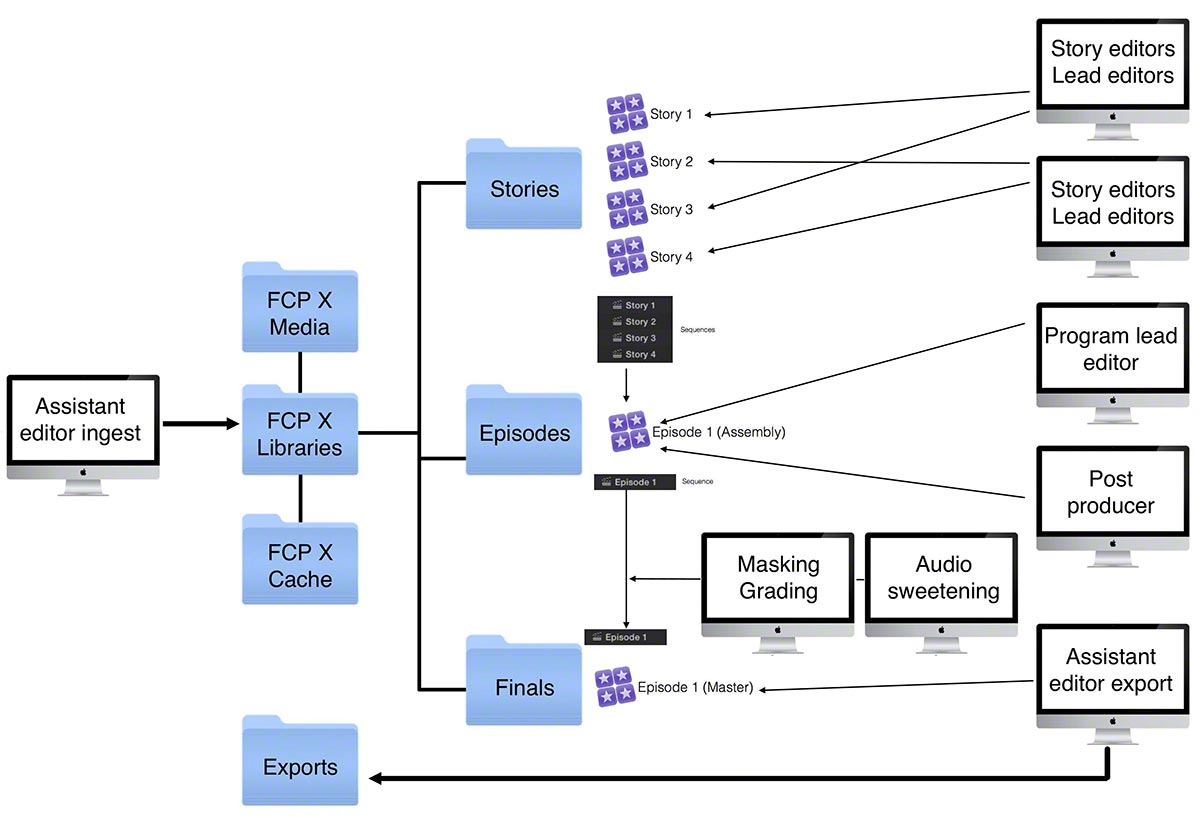
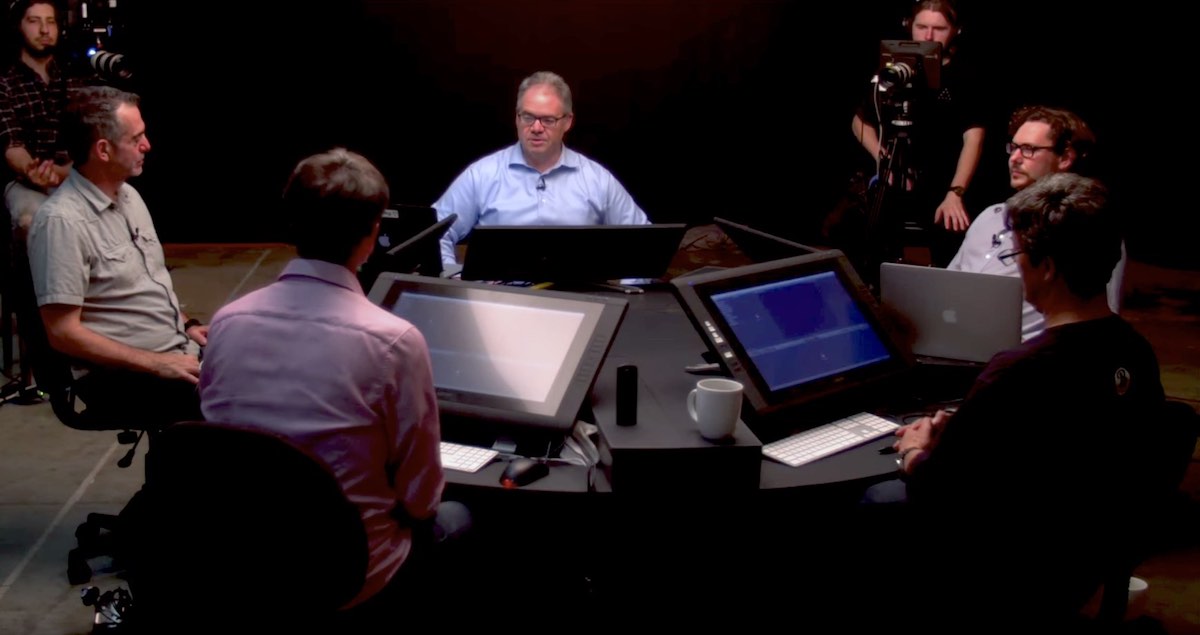

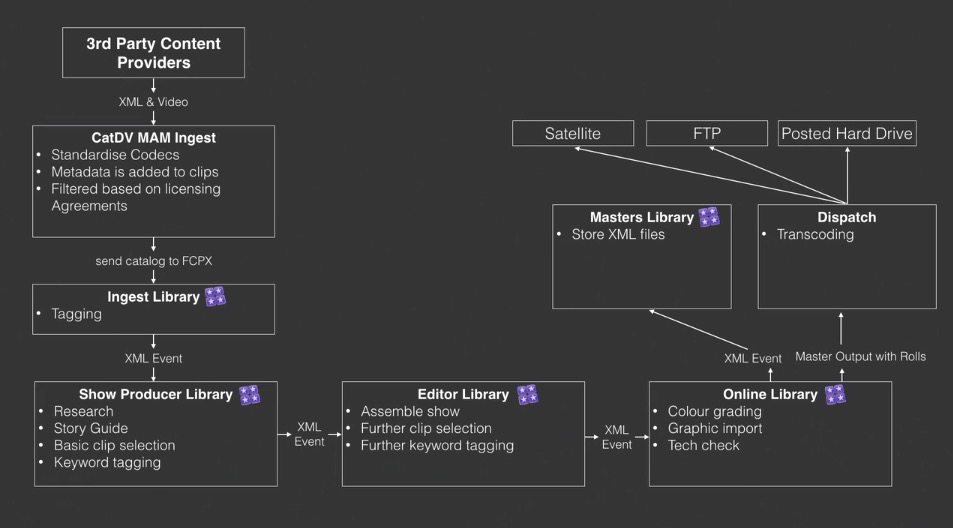
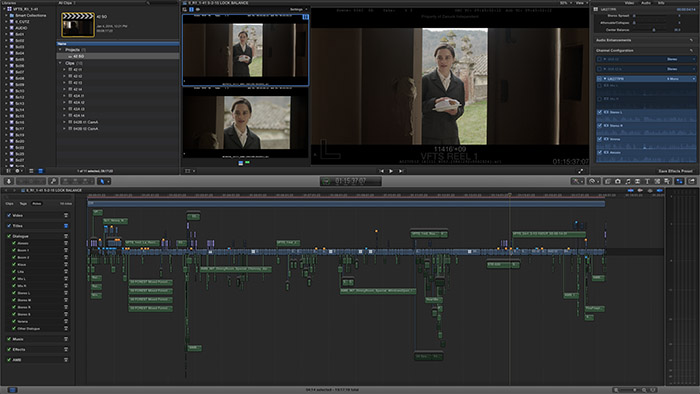
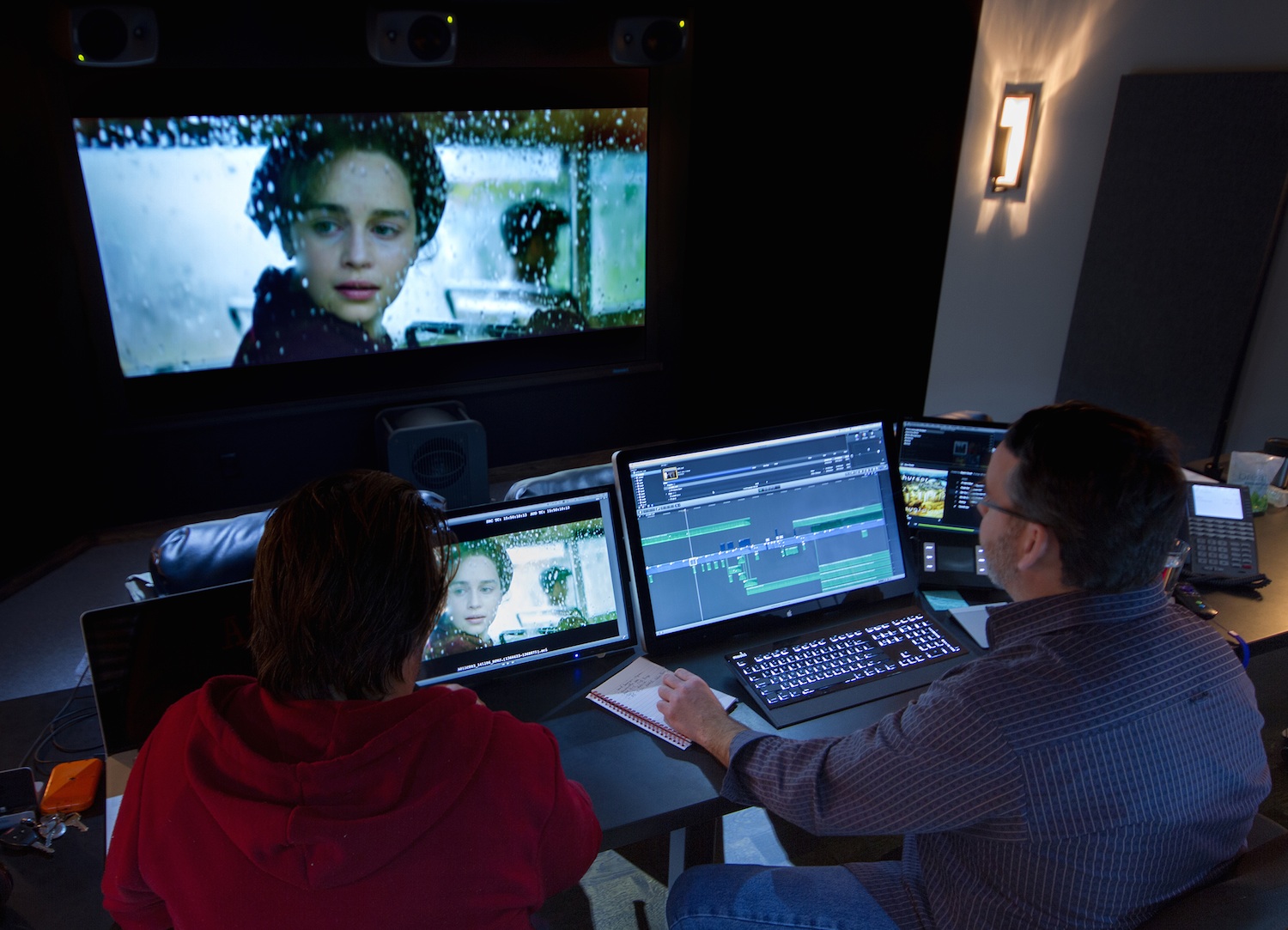




There are also two pro Final Cut guides on the 10dot1 website:
1. How to submit your production as AS-11 to broadcasters and distributors.
2. To plan initial complex workflows using Libraries and different collaboration methods.
Find them at http://www.10dot1.co.uk/guides
Thanks Alex, really helpful!
Thanks for sharing. I’m curious about how post houses handle project and media sharing: So far most of my TV shows (assistant editor) are set up on a varying number of Avid edit bays on some Editshare, ISIS or Unity storage. How well does FCPX behave in a shared work environment, any do’s, don’ts, pitfalls?